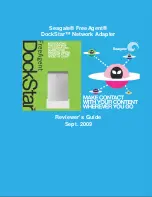
Setup Guide
D-Link Corporation
Page - 7 -
Recommended:
Always check with your NIC manufacturer’s web site to
make sure you have the latest driver—preferably an NDIS
4.0 version. NDIS 4.0 drivers provide instant failover
capability with the load-balancing driver.
NDIS 3.x Drivers
Not all NIC manufacturers have released NDIS 4.0 versions of their drivers.
However, the load-balancing driver can still provide a high level of failover
performance with NIC drivers that do not send “Status Indications.” For non-NDIS
4.0 drivers, the software utilizes “Status Packets” that are generated by load
balancing software so each port can poll the other ports in the array to make sure
they are still alive. This process generates a small amount of traffic on the network
and introduces some latency in the failover process. However, even when using
Status Packets, the software can provide failover within 1 or 2 seconds with only
three to four packets lost on average.
Before You Install - a Checklist
Use this checklist to make sure your environment is set up correctly for the software
to be installed properly. It is highly recommended you follow each of the steps in
the order given.
•
NT 4.0 is running properly.
•
All NICs have been installed and checked for proper operation.
•
All protocols, drivers, and network services are installed in NT and
operate correctly.
•
At least Service Pack 3 has been installed. Service Pack 5 recommended.
•
The necessary Hot Fixes have been installed.
•
All cables, switches and hubs are set up and working properly.
Network Environment Considerations
While testing failover functionality, your network should approach a “real-world”
environment in terms of ambient background traffic. When the number of ports on
the Server is reduced to two and no traffic is on the network, it is more difficult for
load balancing software to detect when a failover situation has occurred (except with
NDIS 4.0 drivers). If your test network consists of one or two clients and a server is
connected on an isolated switch, try to avoid long periods of quiet time on your
network. If adapters with non-NDIS 4.0 drivers do not receive a broadcast packet in
over 2 minutes, determining which port is bad becomes difficult if only two ports are
in use.





































